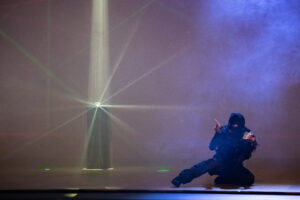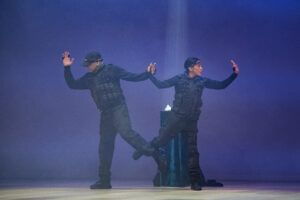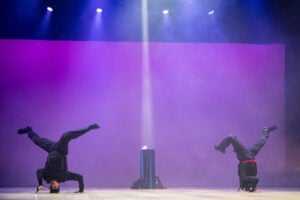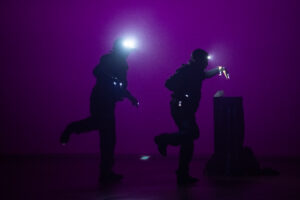
Rokafella (Ana Garcia), is internationally known as a B girl, but is also multi-hyphenate, performing in many styles and wearing many hats besides dancing. Her work includes but is not limited to choreographing or writing, directing, and producing as a content producer for BronxNet TV. She is also a poet, designer and co-founder of a nonprofit dance company called Full Circle productions.
How have your lived experiences informed the many aspects of your work?
Well, I think growing up at the time that I did in New York City, with the family, the adults that I was around who were Puerto Rican (Caribbean Indigenous, Black and Spanish), I witnessed a group of people who were pretty much immigrants who spoke Spanish adapting to mainland culture. They were trying to hold on to their traditions but also shift over and learn, adjusting to what New York City culture and lifestyle could be for a person who is of Latin descent. I was witnessing the way that they were handling, maneuvering the negotiating of their talents and their dreams, their love for their families, and their drive and their ambition. Some did great, some not so great, but in witnessing that it empowered me to feel like I could be somebody. It made me feel that I could create something new and different for myself, while still keeping ties. As courageous and as fun as that sounds, it is also a task and a challenge. It was also a particular challenge as someone who was mixed race, because I was growing up in a predominantly African American neighborhood that had an enclave of Puerto Ricans. It was the duality of having Latin music and Latin news in my apartment, and then going outside and hearing James Brown or Motown or learning about Lindy Hop and tasting my friend’s parents’ foods like collard greens. So I was living a duality already from the jump. And through that I witnessed a lot of brave people who were working, feeding their families and being as vibrant as they could. So I feel like that right there really informed the way I was going to carve a niche for myself in the artistic world, but also in Hip Hop and also in the Latin world.
Along those lines- Who and What do you take inspiration from when you create?
Genuinely, I see what’s happening outside of me, in the world. Then, something gets triggered and something bubbles up and I’ll say “I like that song” or “Wow, I can’t believe that there’s still removal of Indigenous people at Standing Rock or people at the border”. When I see things happening, that can be enraging, but I can work through it in the dance, or my songs. What’s outside affects what’s inside my heart and then I can put something on stage or record something. Alternatively, I use those skills when I’m in a dance class with my students, giving them permission to work through these things with dance too. To me this means giving wings to other people so that they feel they can be a little bit more rebellious with their movements. So it’s not just moves. It’s not just drumming. There’s a purpose behind it and it grounds it.
Hip Hop is really built out of protests and out of community. How does that inform your work?
It is. Even though what you see or hear right now in the mainstream may not elicit that kind of sense, it’s there.
It’s there anytime a person of color is on the mic or centrally framed in a video or orchestrating their own lyrics. There’s something very empowering about it.
Now, the subject matter can be tainted by the record labels’ agendas. So you do have younger and younger lyricists, being primed to put out the same message that is very destructive, depressing and paranoid, as opposed to something that has a little more awareness of power, ownership, and agency. The beginning of Hip Hop took place during a moment of growth and elevation, as evidenced by the increased political activity of organizations like the Young Lords, Black Panthers and Weather Underground. Of course, a lot got squashed, but it still exists underground. It will always exist, there will always be that other vibration. No, no, I don’t mourn or grieve that those big movements were quelled, because it’s still because they’re still here. I’m still here.
But all that being said, I hold it in tandem with my memories of when I was younger. In my college I joined the Puerto Rican club, and they were very independentist. When I came home and told my parents they said “how dare you? You want us to get killed to get Independence?” And I was like, “I didn’t say anything about blood. We’re gonna just be independent.” And they told me not to be foolish. Like yes, be an activist, but realize that when you step out front, the way they get to you is by killing those around you. And if that’s what you want, by all means, go do it. But it’s happened. It’s been done. And our communities learned. And I was like, whoa, whoa. I’m thinking that y’all are punks, but actually there’s something about endurance, strategizing and just doing it a different way that I wasn’t aware of.

How do you balance this endurance as you enter spaces that have traditionally been hostile to Hip Hop and BIPOC artists?
I think, what happens is that I dance you know, and I bring all of that into the moves because the moves are so anti-establishment. Breaking is on the floor. Popping is something that is yet not codified. And so these moves get under people’s skin because people want to just see the ballet, modern, jazz and maybe tap. Modern and ballet are the ones that are upheld the most, are supported the most, despite the fact a lot of street dance styles like voguing and house are global. So when I come into the theater, I know that what I’m bringing already shifts people’s perception and maybe introduces and educates people who have never seen it.
I also have to balance how much I’m educating and how much I’m resisting and being defiant when I enter a traditionally white space. I know that the people I’m interacting with and the production managers and stuff, they just don’t have a lot of experience with this and sometimes assume that only what they know is what’s important. As such I have to somehow educate them. As well to state that “No, I have an intellect and intuition. And I know what I’m putting on paper. And if I left something blank, it’s because it’s blank. It’s blank on stage, and the spontaneous exchange between me and another dancer, that’s freestyle”. I can’t script that and I’m not going to give you a time code and no, it has to be what it has to be. We will be done by 9pm. The curtain will come down, but to give you a full on scripting description just won’t work for us.
As for the audience: if I’m going into a theater that generally has white audiences, it can be jarring for them. They won’t understand the rapping that’s happened, like, lyrics are coming with machine gun speed, or there is street lingo. I think that those audiences are feeling a little bit disconnected. Thus, we do want to incorporate something in the pieces or in the evening, that connects and reaches out and say, hey, you know, this is the story we’re telling and this is the universal truth.

What stories did you tell with the piece that you performed here at Jacob’s Pillow?
“This performance is just a fun performance. If anything, there would be the metaphor of what that diamond represents. You know, why do I want it so bad? Why does Kwikstep want it so bad? Why do we trick each other out of getting it? I trick him I get it. I have it. He takes it in the finale. And so again, it’s like this feeling of outwitting each other constantly. You know, outdoing each other just to get to this thing, and that diamond can represent so many aspects of life it can be real estate, it can be respect, it can be love. Yeah, but just on a superficial level, we’re two burglars who had a romantic history in the past. And we just so happened to run into each other.
There is a lesson in there maybe for relationships or just people generally. I think we’re constantly stabbing each other in the back for this thing, be it commercial acclaim or fame or money or to have a better job.
Either way there are all these layers to that one piece, but to us it’s also important that we are using particular dance styles to bring a story to life on stage. The salsa. The little bit of voguing that’s happening then, you know, to show ‘Okay, well now maybe I’ll use my feminine side as a weapon’. There’s so many layers to this.
In the end, he takes it away from me, so it’s still a male dominated world. And so a lot of times, women should be further along in the race but men always seem to win in the end.“
You’ve been doing this work since the 90s. What is some wisdom that you’ve gained that you try to pass on?
One of the main things I’ve learned is that I do have to be more business minded. We come in enamored, saying “I’m gonna choreograph, I’m gonna sing, I’m gonna paint, all this.. And that’s the first hook. But then the more you do performances, the more you realize it’s “ Oh, wow, you own my likeness and my photos, or wow, he’s getting paid so much more because he’s a man. ”It’s all about knowing your rights and making sure you have access to what you need, whether that be footage or pay.
But I’m optimistic – I feel like young people now have access to knowing their rights, knowing the laws, and they’re way more astute than we were. That’s one of the things I impart when I’m doing a workshop or I’m working day to day or month to month in the Bronx. When it’s a question about culture, I try to let them know that there were other people with similar talents before them and we may not know all the names, and we may know a few of the names of those people who came before us. I tell them that they are the carriers at this moment, and we champion them, but that there is also a long line of people who suffered and sacrificed for them.
The final part I emphasize is that whether they’re Asian or Latino, I try to emphasize the erasure of Blackness and Indigeneity.

I tell my non-Black/Indigenous POC students that “You have to be grounded and you have to know what was happening in the 70s and 80s but also long before.”
I make sure they remember this land’s past of both love (for example the integration of Black formerly enslaved people into some Indigenous tribes), but also the ugliness that took place in the form of colonization and slavery. And I help them connect that to their roots.
What do you see as the role of Hip Hop for the next generation, especially in schools?
It’s really beginning to boom. I think the University of Madison, Wisconsin has a Hip Hop department. Yeah. And even when I was teaching at The New School, there was an MC course. Kwikstep is at CUNY. So I feel like it’s very established right now. We haven’t yet seen the results of this generation’s education and whether we’re doing it right, but I’m excited. I’m excited because this has been a long time coming.
You can learn more about Rokafella through her website, her instagram (@larokafella), or her Facebook (LaRokafella NYC), or the Full Circle Soulja’s website.
This Pillow Pick was edited by Tadea Martin-Gonzalez and published on September 1st, 2023